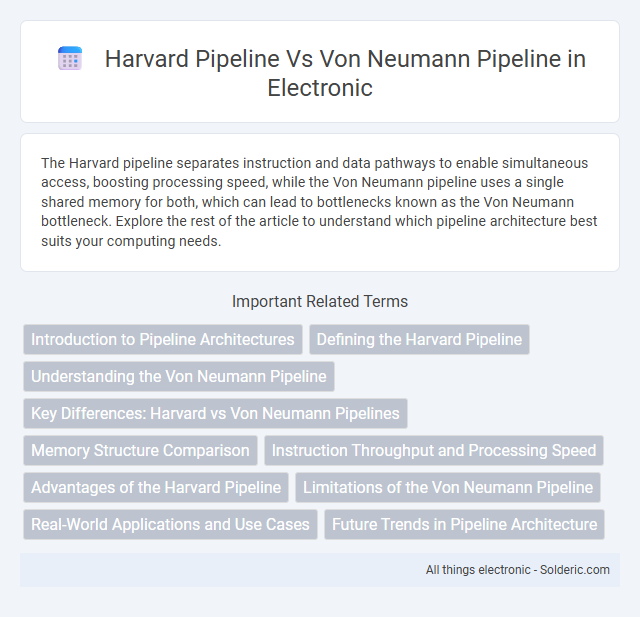The Harvard pipeline separates instruction and data pathways to enable simultaneous access, boosting processing speed, while the Von Neumann pipeline uses a single shared memory for both, which can lead to bottlenecks known as the Von Neumann bottleneck. Explore the rest of the article to understand which pipeline architecture best suits your computing needs.
Comparison Table
| Feature | Harvard Pipeline | Von Neumann Pipeline |
|---|---|---|
| Architecture | Separate data and instruction memory | Unified memory for data and instructions |
| Memory Access | Simultaneous access to instructions and data | Single access port, sequential fetch of instructions and data |
| Pipeline Efficiency | Higher throughput due to parallel fetch | Potential bottlenecks from shared memory access |
| Complexity | More complex memory design | Simpler memory design |
| Use Cases | Embedded systems, DSPs requiring speed | General-purpose computers |
| Instruction & Data Bandwidth | Independent bandwidth channels | Shared bandwidth channel |
Introduction to Pipeline Architectures
Harvard pipeline architecture separates instruction and data streams with distinct memory caches, enabling simultaneous access and reducing bottlenecks in processing. Von Neumann pipeline architecture employs a unified memory for instructions and data, resulting in sequential access that can create pipeline stalls due to resource conflicts. The differentiation in memory organization fundamentally influences the efficiency and throughput of each pipeline design in computing systems.
Defining the Harvard Pipeline
The Harvard pipeline architecture uses separate memory spaces and buses for instructions and data, allowing simultaneous access that increases processing speed and efficiency. Unlike the Von Neumann pipeline, which shares a single memory system causing potential bottlenecks, the Harvard pipeline optimizes data flow and instruction fetch cycles. Your system benefits from reduced latency and higher throughput with the distinct pathways in the Harvard pipeline design.
Understanding the Von Neumann Pipeline
The Von Neumann pipeline follows a sequential process where instruction fetch, decode, and execution occur in a single pipeline path, often leading to bottlenecks due to shared memory access. This architecture merges data and instruction streams in the same memory, causing delays known as the Von Neumann bottleneck. Understanding this pipeline highlights the challenges in parallelism and the need for more efficient designs like the Harvard pipeline, which separates instruction and data paths to improve throughput.
Key Differences: Harvard vs Von Neumann Pipelines
Harvard pipeline architecture uses separate memory and buses for instructions and data, enabling simultaneous access and increasing throughput, while Von Neumann pipeline employs a single shared memory and bus for instructions and data, causing potential bottlenecks. Harvard's distinct pathways facilitate parallel instruction fetch and data operations, improving performance in pipelined processors compared to the Von Neumann model's sequential access. Key differences include memory organization, data path separation, and execution efficiency, with Harvard pipeline architectures preferred for their higher speed and reduced pipeline stalls.
Memory Structure Comparison
The Harvard pipeline architecture features separate memory spaces for instructions and data, enabling simultaneous access to both and improving processing speed. In contrast, the Von Neumann pipeline uses a single unified memory for instructions and data, which can cause bottlenecks due to shared access paths and slower data fetch cycles. Understanding these memory structure differences can help you optimize system design for speed and efficiency requirements.
Instruction Throughput and Processing Speed
Harvard pipeline architecture separates instruction and data paths, enabling simultaneous fetching and processing, which significantly increases instruction throughput and processing speed compared to the Von Neumann pipeline that uses a shared memory bus for both instructions and data. The parallelism in Harvard pipelines reduces bottlenecks, allowing faster execution cycles and higher clock speeds, enhancing overall system performance. Your choice between these architectures affects how efficiently your processor handles instruction streams, with Harvard pipelines often preferred in high-speed, performance-critical applications.
Advantages of the Harvard Pipeline
The Harvard pipeline architecture offers distinct advantages by separating instruction and data memory, enabling simultaneous access which significantly improves processing speed and efficiency. This separation reduces bottlenecks commonly encountered in Von Neumann pipelines, where a single memory path creates resource contention and limits throughput. Harvard pipelines also facilitate optimized memory bandwidth and can support parallel data fetching, enhancing overall system performance in embedded and signal processing applications.
Limitations of the Von Neumann Pipeline
The Von Neumann pipeline is limited by the bottleneck caused by a single shared memory for instructions and data, leading to slower processing speeds and inefficiencies in instruction throughput. Memory access conflicts and the inability to execute simultaneous instruction fetch and data operations reduce overall performance. Understanding these constraints helps you appreciate why modern processors often implement Harvard architectures for improved parallelism and efficiency.
Real-World Applications and Use Cases
Harvard pipeline architecture is widely used in embedded systems and digital signal processing applications due to its separation of instruction and data memory, enabling faster and more efficient parallel access, which optimizes performance in real-time systems and microcontrollers. Von Neumann pipeline architecture remains prevalent in general-purpose computing environments, such as personal computers and servers, where a unified memory simplifies design and supports a broad range of software applications despite potential bottlenecks from shared instruction and data paths. Real-world use cases of Harvard architecture include DSP processors like Texas Instruments' C6000 series, while Von Neumann pipelines are foundational in processors based on x86 and ARM architectures commonly found in desktops and smartphones.
Future Trends in Pipeline Architecture
Future trends in pipeline architecture emphasize the evolution from traditional Von Neumann pipelines toward more parallel and energy-efficient Harvard pipeline designs, enabling simultaneous instruction and data access. Advanced techniques like dynamic scheduling, speculative execution, and machine learning-driven pipeline management enhance throughput and minimize latency in modern processors. Integration of heterogeneous pipelines and support for domain-specific accelerators further define the direction of next-generation CPU and GPU architectures.
Harvard pipeline vs Von Neumann pipeline Infographic

 solderic.com
solderic.com